Home » North Island » Auckland Region » Hauraki Gulf » Waiheke Island » Stony Batter Walkway – WWII Tunnels & Boulder Fields
← Back to all Waiheke Island walks
| Distance | 4.8 km return |
| Time | 1.5-2 hours |
| Difficulty | Moderate |
| Dogs | NOT ALLOWED |
| Parking | Free at road end |
| Track Closure | August 1 – September 30 (lambing) |
| Mobile Coverage | OK at the top |
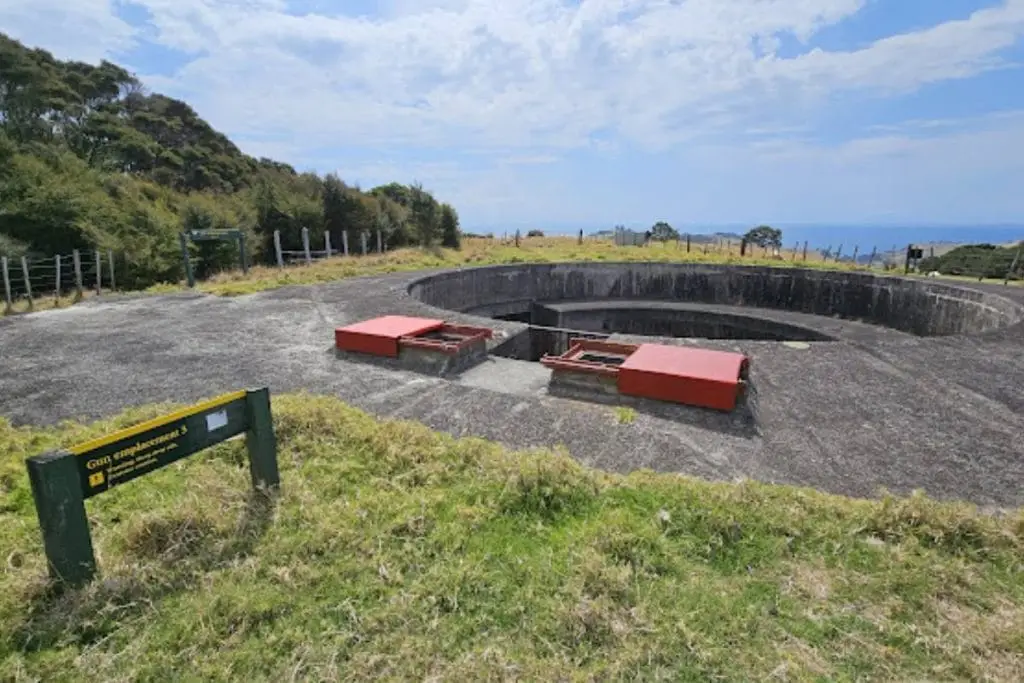
This walk’s a proper adventure – you’ll climb through farmland to reach New Zealand’s best-preserved WWII coastal defence site, wander among massive ancient boulders, and explore underground tunnels dug by hand during the war. The views across the Hauraki Gulf are mint, and the history’s fascinating. It’s remote, there’s a decent climb, and you need a car to get here, but it’s absolutely worth it.
I reckon this is Waiheke’s most unique walk. You’re not coming here for beaches or vineyards – you’re coming for military history, weird geology, and that feeling of being at the edge of the island where tourists don’t usually venture.
Note: The underground tunnels require a guided tour (bookings essential). The reserve, gun emplacements, and boulder field are free to explore anytime.
Starting Point: Stony Batter Road car park, Man O’ War Bay GPS: -36.7428°S, 175.1383°E
This is at the far eastern end of Waiheke – about 40 minutes’ drive from Matiatia Ferry Terminal through beautiful countryside.
Driving Directions from Matiatia:
Public Transport: There’s NO regular bus service out here. Your options:
Parking: Free parking at the end of Stony Batter Road. There’s room for maybe 10-15 cars. It gets busy on weekends and during school holidays – come early.
This is an out-and-back walk along a farm road through private farmland to reach the DOC reserve at the top. The track’s well-defined but crosses working farmland, so respect the rules.
CRITICAL: Track closed August 1 – September 30 for lambing season
1. Car Park to Farmland Climb (0-0.8 km, 20-25 minutes)
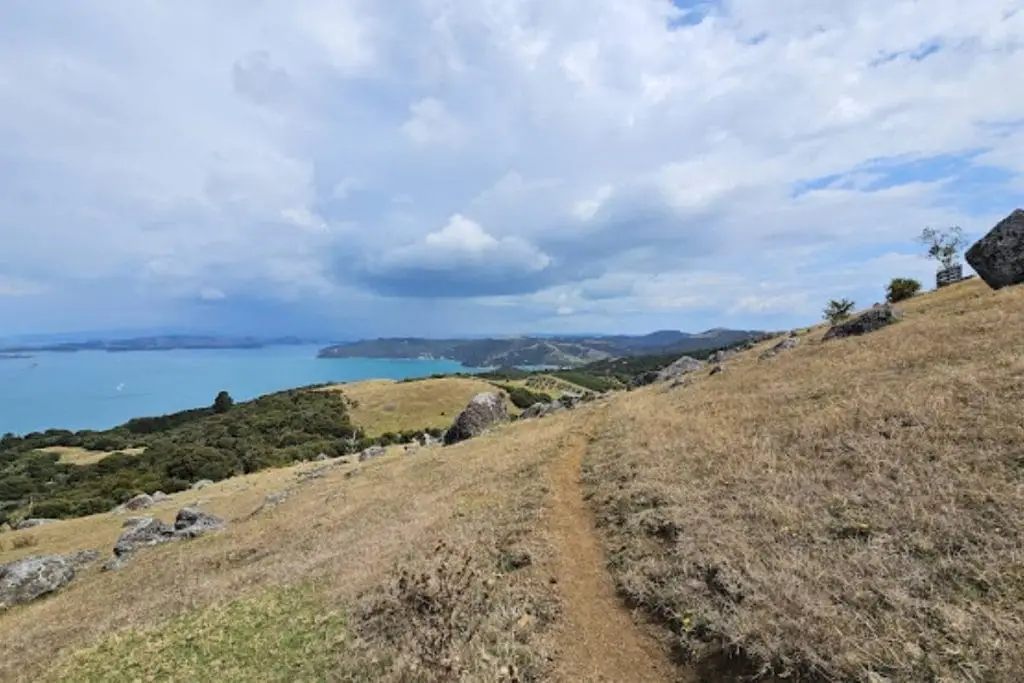
From the car park, walk through the gate (close it behind you – this is working farmland with sheep and cattle). The farm road immediately starts climbing. This first section’s the workout – you’re gaining about 150-180m elevation over the next 800m.
The road’s a well-maintained gravel track. Follow the main farm road – it’s obvious. You’ll pass through open farmland with sheep grazing. The cows can be curious, so give them space but they’re generally chilled.
Views start opening up behind you – turn around occasionally to see the Hauraki Gulf spreading out. On a clear day, you can see Coromandel Peninsula to the east.
2. Through the Farmland (0.8-1.6 km, 15-20 minutes)
The climb eases off a bit. You’re walking through gorgeous rolling farmland now, with native bush remnants on your left (west side). The boulders start appearing – massive andesitic rocks scattered across the hillside like a giant’s marbles.
These boulders give Stony Batter its name. They’re remnants of an 8-million-year-old basalt volcano, and they’re weirdly fascinating. Some have karst features (water-erosion patterns), which is super rare with basalt rock.
Keep following the farm road. At about 1.5 km, you’ll reach an intersection where the road forks. Veer right and uphill towards the reserve entrance.
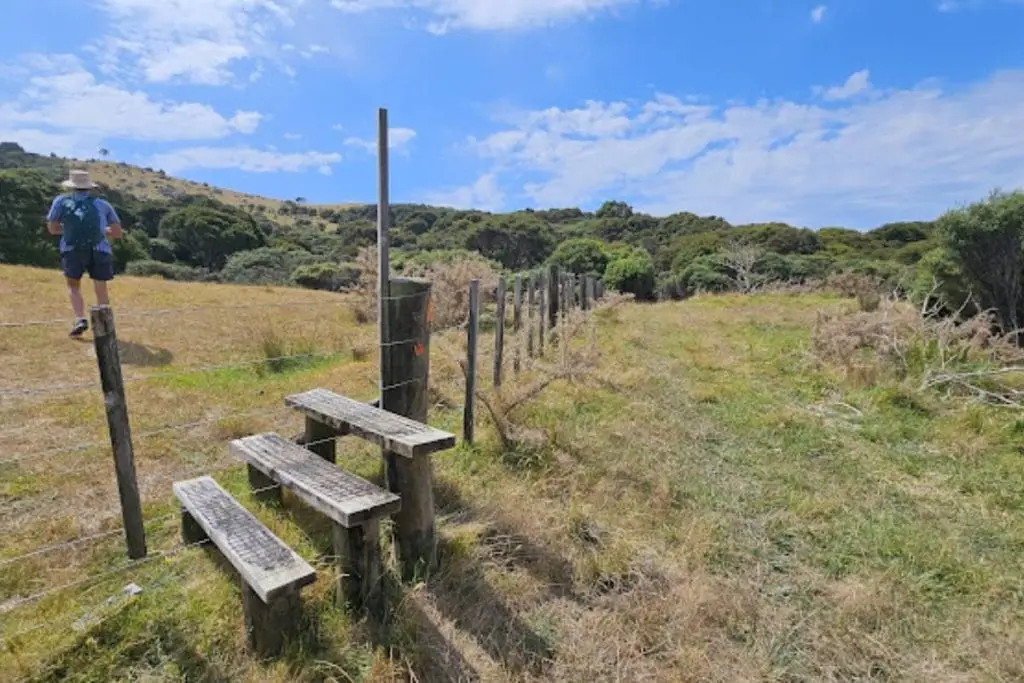
3. Entering Stony Batter Historic Reserve (1.6-2.4 km, 10-15 minutes)
You’re now in the DOC-managed Stony Batter Historic Reserve. The landscape changes dramatically – you’re surrounded by massive boulder outcrops and ancient volcanic rock formations.
The first thing you’ll notice is the concrete. Three enormous gun emplacements sit among the boulders like brutalist sculptures. Each one’s about 30 feet deep, built to withstand direct enemy bombardment. The scale is impressive – these were designed to house 9.2-inch guns that could hit targets 32 km away.
4. Exploring the Reserve (variable time)
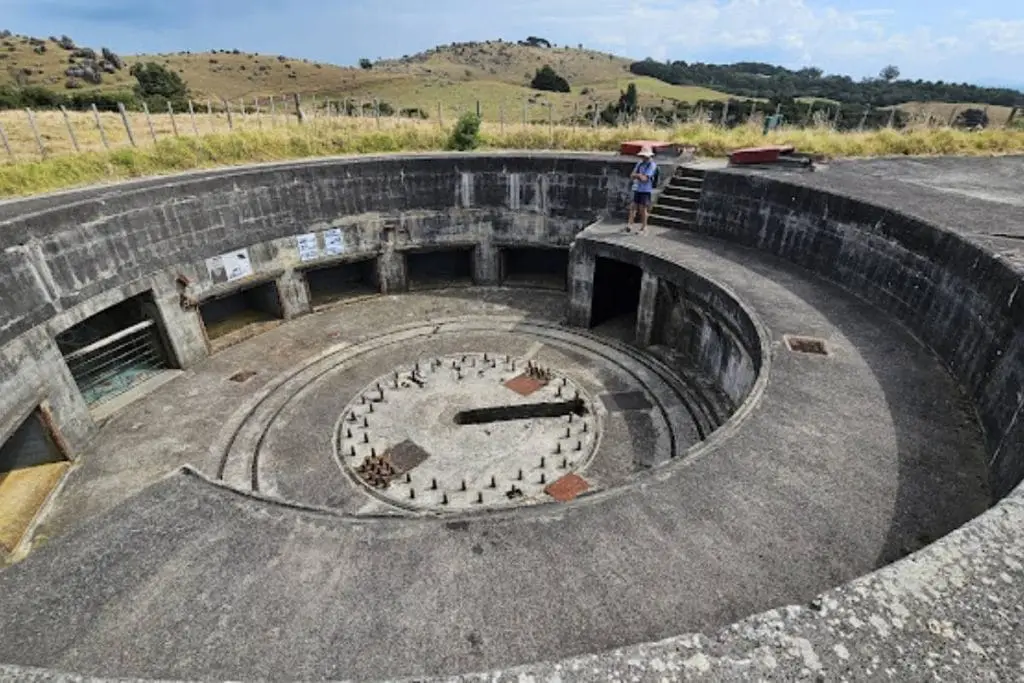
Once you’re in the reserve, you can explore freely (except during tunnel tours – respect tour groups). Here’s what to check out:
5. Return Journey (2.4 km back to car park, 40-50 minutes)
Retrace your steps down the farm road. The descent’s much easier, though watch your footing on the gravel. The views on the way down are different – you’re looking out to sea now rather than at your feet during the climb.
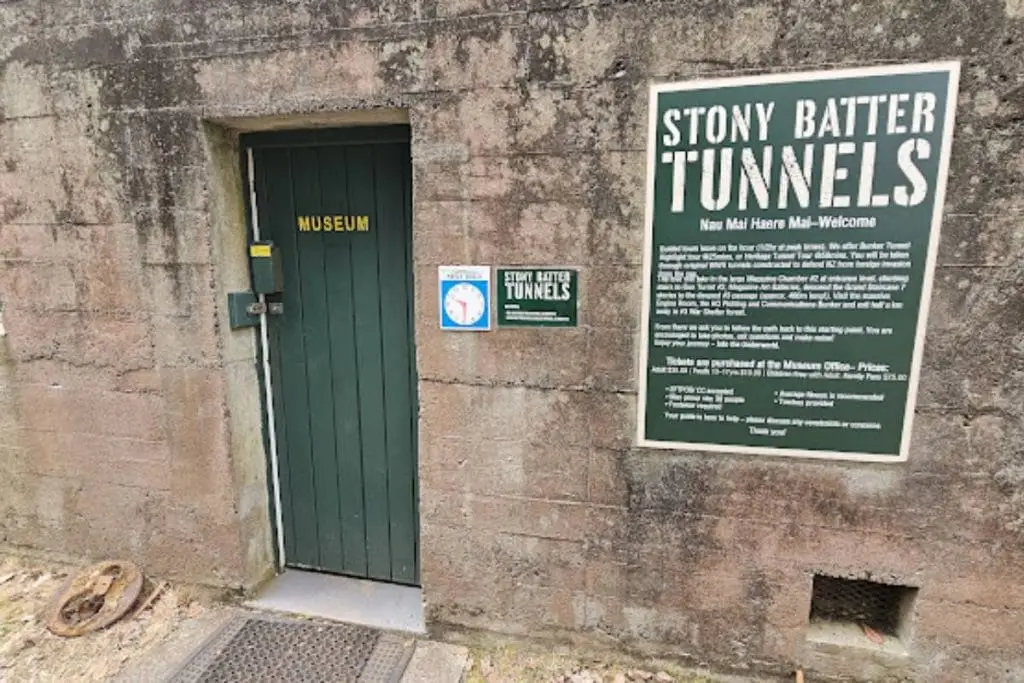
The underground tunnel system is the real highlight of Stony Batter. While you can enjoy the walk and see the gun emplacements without a tour, going underground is where the history comes alive.
Booking: You MUST pre-book tours through www.stonybattertunnels.nz or phone +64 21 483 425. Tours fill up quickly, especially in summer and on weekends.
Tour Times: Thursday-Sunday, tours run from 10:30am (first tour) to 4:15pm (last tour) Tours run every 30 minutes Closed Monday-Wednesday
Cost: Around $30-35 per adult (check website for current prices and family rates)
What You’ll See:
Tour Duration: About 60-90 minutes underground
What to Bring:
Accessibility: The tunnel tours involve stairs and uneven surfaces. Not suitable for wheelchairs or those with significant mobility issues. Check with operators about specific concerns.
History: This is New Zealand’s largest and best-preserved WWII coastal defence installation. Built in absolute secrecy between 1943-1945 to protect Auckland from Japanese invasion, the whole complex was designed to take direct enemy fire. The three 9.2-inch guns could fire shells 32 km – far enough to reach from Waiheke to Coromandel. They were test-fired once in 1951, and the blast broke windows in Coromandel Town, 30 km away. The guns were never used in combat and were scrapped in the 1960s.
Geology: The boulder field is genuinely unusual. These massive andesitic boulders are remnants of an 8-million-year-old volcano. The karst erosion patterns (where water has carved weird shapes into the rock) are extremely rare on basalt. The builders used these boulders as aggregate for the concrete – practical and clever.
Views: From the reserve, you’re looking at one of the best panoramas on Waiheke:
Wildlife: The reserve has resident weka (native flightless birds – they’re curious and will check you out), native lizards (geckos), and plenty of birdlife in the bush remnants. The surrounding farmland has sheep and cattle.
Native Bush: There are three significant bush blocks within the reserve, protecting remnant native forest. You’ll see puriri, pohutukawa, and various coastal species.
Surface:
The Climb: Don’t underestimate this walk. The first 800m gains 150-180m elevation – that’s a proper climb. It’s not technical, just relentlessly uphill. If you’re reasonably fit, you’ll manage fine, but you’ll feel it.
Muddy Sections: The farm road can get muddy and slippery after rain. The grass sections around the boulders can be soggy in winter. Wear proper walking shoes with grip – this is NOT a walk for jandals or smooth-soled shoes.
Exposure: Once you’re out of the bush on the climb, you’re completely exposed to sun and wind. The top can be seriously windy – bring a windbreaker even on calm days at sea level.
Seasonal Closure: Track is closed August 1 – September 30 for lambing. This is strictly enforced. Don’t try to sneak in – the farmers need this time.
Perfect For:
Fitness Level: Moderate. The climb requires decent fitness. If you can walk uphillfor 20-25 minutes without stopping, you’ll be fine. The descent’s much easier.
Not Ideal For:
Kids: Kids 10+ who like exploring will love this – the tunnels, gun emplacements, and boulders are like a giant playground. Younger kids will struggle with the climb and attention span for the history. The tunnel tours are fascinating for kids interested in war history.
Accessibility: Not accessible for wheelchairs or strollers due to the steep farm road and rough terrain in the reserve.
Best Times: This walk’s good most of the year, but timing matters:
Spring (September-November): Perfect. Mild temperatures, wildflowers, and you’ll miss the worst of summer crowds. Just check lambing closure dates – track reopens October 1.
Summer (December-February): Busy but beautiful. Come early (aim to start by 9am) to beat the heat – there’s minimal shade on that climb. The reserve gets hot, and you’ll be glad of morning coolness. Tunnel tours book out quickly in summer, so reserve well ahead.
Autumn (March-May): Excellent. Weather’s still good, fewer visitors, and the afternoon light is gorgeous for photos. Less wind than summer.
Winter (June-August): Track is closed August-September, but June-July is fine if you don’t mind cold and wet. The climb will warm you up, but the top can be brutal in strong winds. Good for avoiding crowds, but check weather carefully. Tunnel tours may have reduced hours.
Time of Day:
Avoid Crowds: Weekdays are way quieter than weekends. If you can visit Tuesday-Thursday, you’ll often have the place to yourself outside of tour times.
Dogs: ABSOLUTELY NOT ALLOWED
No dogs on this walk, full stop. This is:
Leave your dog at home or in your accommodation. This is non-negotiable.
Land Access: The farm road crosses PRIVATE farmland owned by Man O’ War Station. You’re walking on a public accessway, but the land either side is private. The reserve itself is DOC land.
Rules:
Facilities:
Safety:
What to Bring:
Seasonal Closure: August 1 – September 30 annually for lambing. Don’t ignore this – the farmers need it, and you’ll be trespassing.
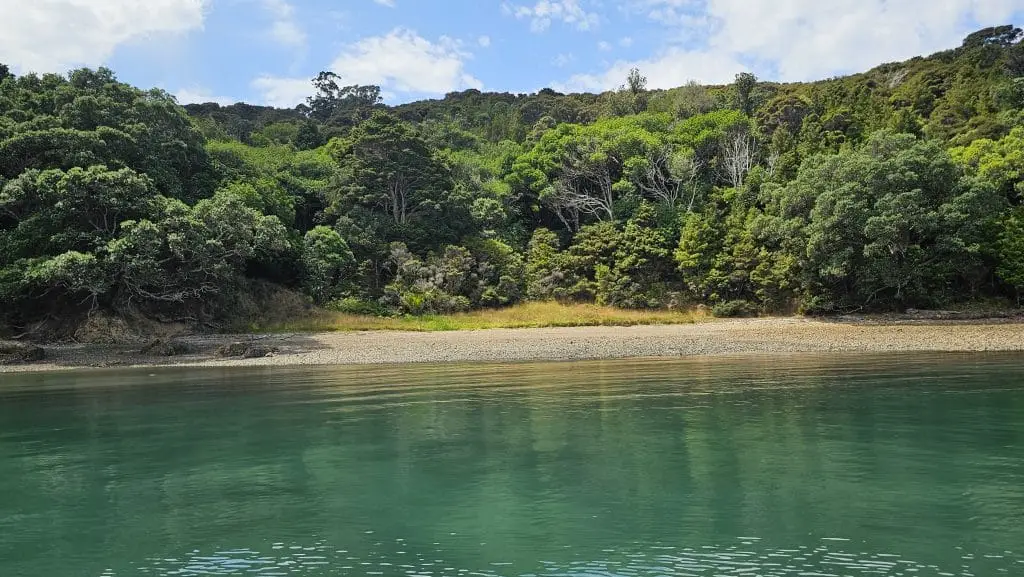
I actually came in by boat, which totally changed the experience. We anchored at this gorgeous little unnamed beach right between Opopo Bay and Man O’ War Bay – it’s marked on my 3D map. Starting from sea level on the beach made that climb even more brutal than coming from the car park, but arriving by water felt properly adventurous. The beach itself was stunning, and having it basically to ourselves was mint.
The walk description above is from the standard car park start (which is what most people do), but if you’ve got access to a boat, I’d 100% recommend the beach route. You’ll see a slightly hidden track sign (grass was growing over it when we visited) right at the beach. The claim is it takes an hour to the reserve, but we knocked it out in about 45 minutes – though we’re reasonably fit and didn’t stop much.
Fair warning though – starting from the beach means you’re climbing from sea level rather than from the car park elevation, so it’s a bigger workout. But the sense of remoteness is incredible. You feel like you’re discovering something hidden rather than just following the tourist trail.
Once we reached the reserve, I was blown away. I’d seen photos of the gun emplacements and thought “yeah, looks interesting,” but being there is completely different. The scale of the military engineering is mind-blowing – these tunnels were dug BY HAND through solid rock during wartime. The fact they’re so well-preserved makes it even better.
Wandering among those massive boulders with the gulf spread out below felt like we’d discovered something special. The remoteness added to it – whether you arrive by boat or car, you’re at the far edge of Waiheke where most tourists never go. The cows in the paddocks were curious but chilled, which was entertaining.
On the return, I walked back down to the beach, and the weather was so lovely I just swam out to the boat instead of getting back in the dinghy. That’s one of the best things about the beach approach – you can cool off with a swim after that sweaty climb. You’re not getting that option from the car park!
I didn’t do the tunnel tour on that visit (the tunnels were closed when I went), but I’ve been back since and the tours are brilliant. The guides are passionate about the history and full of stories. Seeing the engine rooms, plotting rooms, and ammunition stores brings the whole war defence story to life. The chambers are genuinely huge – way bigger than I expected underground.
The downside? Unless you’ve got a boat like we did, you need a car. There’s no easy public transport option, and it’s too far to cycle unless you’re keen. Also, if you’re not into history, you might find it a bit meh – this walk is 60% about the WWII story and 40% about views and geology. If you just want a beach walk, go elsewhere.
Would I do it again? Already have! The boat approach was brilliant, but I’ve also done it from the car park since. Both are good – the boat feels more adventurous, the car park is more practical.
Who’d I recommend it for?
Skip it if:
Eastern End Options:
Back Towards the Main Island:
Connecting to Te Ara Hura: Stony Batter is part of the Te Ara Hura walkway network. The Onetangi to Man O’ War Bay walk connects with Stony Batter, and you can piece together multi-day routes exploring the eastern end.
GPS Coordinates:
Key Contacts:
Last Updated: October 2025